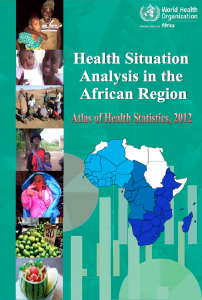
The Atlas of Health Statistics, 2012, which provides a health situation analysis of WHO’s African Region, is the most significant data output of the African Health Observatory. Now in its second edition, the Atlas is building on the ground-breaking work that was carried out in preparing the initial edition. Not only has it been updated for 2012, but its coverage has expanded and further indicators have been included.
This resource includes statistics on:
- Prematurity
- Skilled birth attendance
- Antenatal care coverage
- Neonatal sepsis
- Birth asphyxia
- Births by caesarean section
- HIV/AIDS
- Exclusive breastfeedng
The data comes from the countries, and we are entirely reliant on data collection, cleaning, correction, evaluation and assessment carried out first of all at country level in each of the 46 Member Countries of WHO’s African Region. These data are further reviewed and refined in WHO, both in its African country offices and Regional Office, and by technical experts at WHO headquarters in Geneva. Mortality estimates that are used to monitor internationally agreed goals, such as the MDGs, are produced by inter-agency groups consisting of members from WHO, UNICEF, and World Bank among others. The results of this system of analysis is data which is as good as can be extracted from the raw inputs.
Looking back at the raw inputs, it is clear that the quality, quantity, frequency of collection, and timeliness of data depends very much on the strength of the national health information systems, which include data collection at the district and peripheral levels. With some notable exceptions, this has been an area of weakness within most national health systems. By and large, the development of national health information systems has been slow and uneven, despite many efforts over the years.
WHO seeks to support countries in strengthening their national health information systems, and one mechanism that is being developed in response to demands from the countries is the establishment of a network of national health observatories. With support from WHO’s Regional Office for Africa, a number of countries have taken steps to set up such observatories, often with direct links to the district level, as a way to reinforce the national health information system. The national observatories also link to the African Health Observatory, in a collaborative, two-way system of information, evidence and knowledge exchange. Such observatories serve at both the regional and national levels as platforms for other activities designed to foster monitoring and evaluation, which are essential components of the cycle of development and policy work that lead to national health policies and health development plans.
Thus, the collaborative networking approach embraced by the African Health Observatory and the national observatories is intended to provide a continuum between work at the regional and national levels, offering a platform for many disparate supporting mechanisms and methodologies. This should lead to a marked decrease of the fragmentation of efforts so frequently found in public health policy and development work. The Atlas is a product and promoter of such collaborative networking.